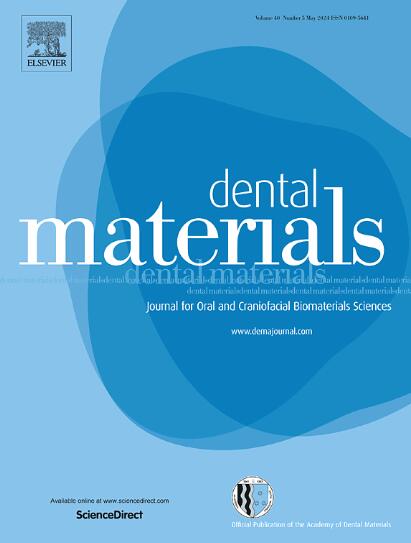Two-step sintering suppresses grain growth and improves flexural strength of dental zirconia
IF 4.6
1区 医学
Q1 DENTISTRY, ORAL SURGERY & MEDICINE
引用次数: 0
Abstract
Objectives
This study aimed to elucidate the effect of various two-step sintering (TSS) protocols on the physical, mechanical, and optical properties of partially stabilized zirconia with different yttria dopant concentrations (Y-PSZ).
Methods
Disc-shaped specimens were obtained from most widely used commercial dental zirconia powders of various Y contents (Tosoh Corp.) by uniaxial pressing followed by cold-isostatic pressing. Densification was carried out using TSS protocols with varying temperatures for both sintering steps. Relative density (ρRel), microstructure, and phase content were analyzed. Biaxial flexural strength (σ) and translucency parameter (TP) were evaluated.
Results
The TSS results were compared with optimized conventional sintering (CS) results from a previous study for the same Y-PSZ compositions. TSS 3Y-PSZ and 4Y-PSZ reached similar ρRel to those of their CS counterparts, whereas 5Y-PSZ failed to achieve that regardless of TSS protocol. TSS yielded less cubic phase compared to CS, especially for 3Y-PSZ and for higher temperatures. TSS suppressed the grain growth throughout the temperature range investigated, promoting smaller grains than CS (p < 0.05). The TP values for TSS Y-PSZ were lower than those of CS (p ≤ 0.0001), except for 3Y-PSZ. The σ values for TSS Y-PSZ were significantly higher than those of CS (p ≤ 0.0002).
Significance
TSS increased strength without significantly jeopardizing the optical properties of various Y-PSZ compositions relative to their CS counterparts. This alternative sintering method appears to be a promising technique for controlling grain growth while eliminating porosities in dental Y-PSZ ceramics, thus potentially enhancing the clinical longevity of zirconia restorations.
两步烧结抑制了氧化锆的晶粒生长,提高了氧化锆的抗折强度。
目的:研究不同的两步烧结(TSS)工艺对不同钇掺杂浓度(Y-PSZ)的部分稳定氧化锆的物理、力学和光学性能的影响。方法:用Tosoh公司生产的各种含Y含量的牙用氧化锆粉进行单轴挤压,再进行冷等静压,获得圆盘状试样。在两个烧结步骤中使用不同温度的TSS协议进行致密化。分析相对密度(ρRel)、微观结构和相含量。测定了材料的双轴抗折强度(σ)和透光性参数(TP)。结果:对相同Y-PSZ成分的TSS结果与优化后的常规烧结(CS)结果进行了比较。TSS - 3Y-PSZ和4Y-PSZ的ρRel与CS相似,而5Y-PSZ的ρRel与TSS协议无关。与CS相比,TSS产生的立方相更少,特别是在3Y-PSZ和更高温度下。在研究的整个温度范围内,TSS抑制了晶粒的生长,使晶粒比CS更小(p)。意义:与CS相比,TSS提高了强度,但没有显著损害各种Y-PSZ成分的光学性质。这种替代烧结方法似乎是一种很有前途的技术,可以控制晶粒生长,同时消除牙科Y-PSZ陶瓷中的孔隙,从而潜在地提高氧化锆修复体的临床寿命。
本文章由计算机程序翻译,如有差异,请以英文原文为准。
求助全文
约1分钟内获得全文
求助全文
来源期刊

Dental Materials
工程技术-材料科学:生物材料
CiteScore
9.80
自引率
10.00%
发文量
290
审稿时长
67 days
期刊介绍:
Dental Materials publishes original research, review articles, and short communications.
Academy of Dental Materials members click here to register for free access to Dental Materials online.
The principal aim of Dental Materials is to promote rapid communication of scientific information between academia, industry, and the dental practitioner. Original Manuscripts on clinical and laboratory research of basic and applied character which focus on the properties or performance of dental materials or the reaction of host tissues to materials are given priority publication. Other acceptable topics include application technology in clinical dentistry and dental laboratory technology.
Comprehensive reviews and editorial commentaries on pertinent subjects will be considered.
 求助内容:
求助内容: 应助结果提醒方式:
应助结果提醒方式:


